Physical Therapy
Physical therapy (PT) is a key component in the healthcare industry that focuses on improving the physical function and mobility of patients while taking care of their pain, avoiding impairment, and promoting general fitness and health.

Physical therapy is a branch of medical service that concentrates on recovering mobility, enhancing performance, and relieving pain with particular remedial measures. Involving itself in different specializations that deal with various health issues such as orthopedic injuries or neurological disorders, it works closely with patients to come up with personal treatment programs designed especially for each one’s needs, thereby ensuring that they get maximum attention depending on their condition. This individualized strategy lays the foundation for attaining the best results in health care.
What are the four main types of physical therapy?
The four main types of physical therapy are orthopedic, neurological, pediatric, and geriatric. Orthopedic therapy focuses on musculoskeletal injuries, neurological therapy treats nervous system disorders.
Pediatric therapy helps children with developmental problems. Geriatric therapy deals with age-related conditions. Each of these categories contains numerous techniques directed toward specific patient needs, including manual therapy to assist with pain relief and exercise to enhance balance and prevent falls.
Pediatric therapy may involve play activities to promote participation, and geriatric therapy focuses on independence. These modalities enable the restoration of function, pain management, and enhancement of the quality of life.
How does orthopedic physical therapy help with rehabilitation?
Orthopedic physical therapy aids rehabilitation by focusing on restoring function, mobility, and strength to the musculoskeletal system. Therapists use exercises, manual therapy, and modalities like ultrasound to reduce pain and improve movement, assisting recovery from injuries or surgeries.
Individual treatment plans by the therapists focus on the body’s particular parts injured, hence ensuring a holistic healing process. Some of the techniques constituting joint mobilization and therapeutic exercises aid in strengthening muscles and increasing flexibility for returning the patients safely and efficiently to their pre-injury active state. It also reduces the possibility of re-injury and fosters improved wellness.

What role does neurological physical therapy play in stroke recovery?
Neurological physical therapy plays a crucial role in stroke recovery by helping patients regain motor skills and improve balance and coordination. Therapists use techniques like gait training and neuro-reeducation to enhance neural plasticity and promote independence.
Through repeated and specific exercises, therapists can stimulate the brain’s potential to reorganize itself and create new pathways, which reactivate lost capabilities, thereby restoring independence in daily activities.
Regular therapy enhances the patient’s physical capacities and quality of life by boosting self-confidence and minimizing future possible complications. Individual treatment programs are incorporated to meet the needs and objectives of each patient.
How does pediatric physical therapy support children with developmental delays?
Pediatric physical therapy supports children with developmental delays by enhancing motor skills, balance, and coordination.
The therapists design play and fun activities that will encourage movement and functional development. Most of the therapy involves family education to reinforce activities done at home. This form of therapy is tailored to the child’s strengths and weaknesses.
It may include crawling, jumping, or balancing activities to prompt total physical development. Parent involvement enables carry-over into daily life and can be very effective. Therapy helps a child to achieve developmental milestones by providing him with confidence and socialization.
What benefits does geriatric physical therapy offer to older adults?
Geriatric physical therapy offers benefits to older adults by improving mobility, balance, and strength, reducing the risk of falls. It helps manage chronic conditions like arthritis and osteoporosis through personalized exercise programs.
It improves general well-being and independence and makes one focused. The therapists shift their focus to functional exercises that help in supporting daily activities like walking, climbing stairs, or lifting of objects.
Such therapy targeting the age-related challenges more specifically shall help the individual sustain autonomy and enhance the quality of life. Regular sessions make an individual more physically active, develop good postures, reduce pain, and provide better conditions towards active and healthy living.

What are the main techniques used in physical therapy?
Physical therapy techniques include manual therapy, therapeutic exercises, electrotherapy, and hydrotherapy. Manual therapy involves hands-on manipulation to improve mobility, while exercises target strength and flexibility.
Electrotherapy is electrical stimulation that relieves one from pains, while hydrotherapy makes use of water’s buoyancy and resistance. The techniques to be applied will depend on the needs and conditions of each patient. Manual therapy helps in releasing the restricted joints, and the exercises optimize the working of the muscles.
Electrotherapy reduces inflammation and promotes healing, while hydrotherapy was given to the service of rehabilitation through low-impact resistance exercises, mainly for those people who have mobility problems.
How can physical therapy be tailored to individual patient needs?
Physical therapy can be tailored to individual patient needs through personalized assessments and treatment plans. Therapists evaluate the patient’s condition, goals, and lifestyle to design specific exercises and interventions.
Treatment adjustments will be based on progress toward optimal results. This allows focused intervention to solve the peculiar challenge of every patient, therefore contributing to his effective recovery.
Further monitoring of progress allows therapists to fine-tune techniques to elicit maximum therapeutic benefits. Individual therapy gives rise to better engagement and motivation of the patients; thus, effective rehabilitation with long-term health improvement results.
Adopting Physical Therapy for Better Health
The main types of physical therapy are orthopedic, neurological, cardiopulmonary, and geriatric each designed to treat a certain health problem such as arthritis or heart disease. It is important to choose the right kind of physical therapy and this starts with an initial examination that helps determine what would work best for you. Finding the correct physician will set you off on a path toward better mobility; lessened aches and improved overall quality of living.
Physical Therapy
Physical therapy (PT) is a key component in the healthcare industry that focuses on improving the physical function and mobility of patients while taking care of their pain, avoiding impairment, and promoting general fitness and health.
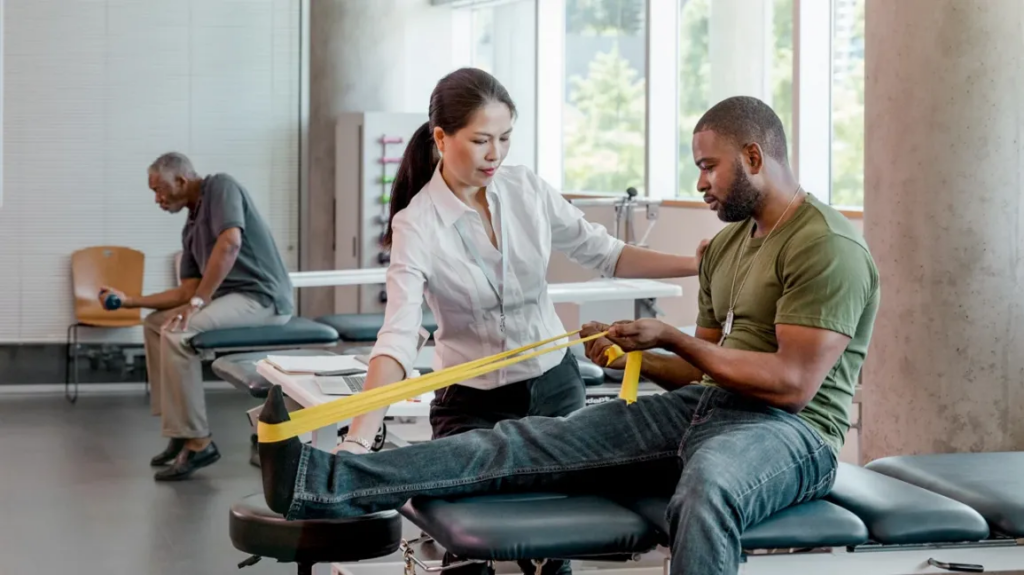
The common misuse of the terms “physical therapy” and “physiotherapy” has led to the assumption that they mean the same thing. This blog post will consider the similarities and contrasts between these two medical disciplines, their beginnings, the approaches they use, and their usage in modern medicine.
What Are The Historical Origins of Physical Therapy and Physiotherapy?
Historically physical therapy began in early 1900s America for WWI soldiers, while physiotherapy started in late 19th-century UK with massage and exercise, formalized in 1894.
The profession of physical therapy began in the early 1900s, mainly in America. Its roots can be traced back to caring for soldiers during World War I. First, physical therapy programs were set up to train ‘’reconstruction aides’’ who helped soldiers injured in combat regain function and movement.
Physiotherapy has been around for a long time, starting towards the end of the nineteenth century in the United Kingdom. It developed from nurses and midwives using massage and exercise techniques. The term physiotherapy was first used in 1894 when four nurses established the Chartered Society of Physiotherapy England.
What Are The Education and Training Required for Physical Therapy and Physiotherapy?
In terms of education in the USA, physical therapists complete a three-year DPT program and licensure exam. Internationally, physiotherapists typically earn a bachelor’s or master’s degree with varying focuses.
In the USA, physical therapists are required to complete a three-year Doctor of Physical Therapy (DPT) program after acquiring a bachelor’s degree. The curriculum entails units on anatomy, physiology, biomechanics, and clinical sciences, among other subjects. After graduation, DPT graduates must pass a national licensure examination before they can practice.
Educational requirements for physiotherapists differ across countries. In many parts of the world including the UK, Australia and Canada physiotherapists undergo a bachelor or masters program in physiotherapy. The programs cover similar subjects to physical therapy but may have slight variations in focus or duration.
What Are The Scopes of Practice of Physical Therapy and Physiotherapy?
Physical therapists in the US have the scope to handle diverse conditions and may be direct caregivers. Physiotherapists’ scope is similar but varies by country in independence and collaboration.
In the United States, physical therapists have a broad scope of practice, which includes: musculoskeletal disorders, neurological conditions, cardiopulmonary rehabilitation, pediatric, sports injuries, etc.
It is worth mentioning that physiotherapists’ scope of practice is generally similar to that of physical therapists.
Some countries allow physiotherapists more independence in prescribing medications or carrying out diagnostic tests. In some places, physical therapy puts more focus on manual treatments than others do.
Different countries might have varying degrees of interprofessional collaboration between PT and other healthcare professions.
How Does Physical Therapy Work?
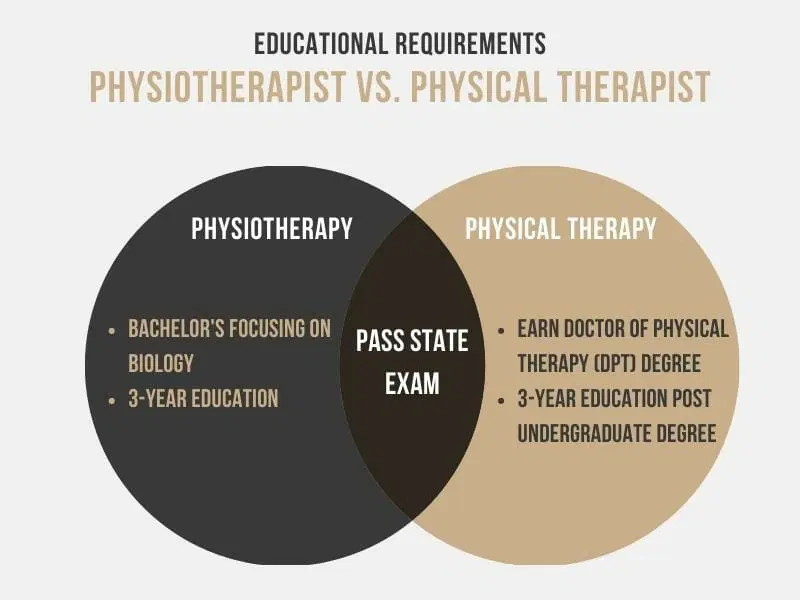
Physical therapy uses techniques like exercise, manual therapy, and education to treat musculoskeletal, neurological, and other conditions, aiming to restore function and improve movement.
Physical therapy (PT) encompasses exercises as well as manual techniques aimed at enhancing mobility, function, and strength. As practitioners, they would examine the nature of a patient’s condition, after which they would develop tailor-made treatment plans focused on addressing issues like pain management or injury recovery for long-term illnesses.
Preoperative and postoperative PT may involve stretching, weight training, balance exercise, or other modalities such as ultrasound or electric stimulation during therapy sessions. Regular sessions and at-home exercises can help patients maintain overall health and prevent future injuries.
What Are The Specialties and Advanced Practice of Physical Therapy and Physiotherapy?
In the US, physical therapy offers specialized certifications in areas like orthopedics and neurology. Physiotherapy globally includes similar and additional specializations, often requiring postgraduate education and experience.
Physical therapy in the US offers specialized certifications in different areas of specialization. These include orthopedics, neurology, pediatrics, geriatrics, cardiovascular & Pulmonary Rehabilitation, etc.
These certifications require additional education, clinical experience, and passing a specialty exam.
Sometimes, physiotherapists may choose their specialization depending on country practices and rules of registration with a professional body.
Common areas of specialization may consist of musculoskeletal physical therapy, neurological rehabilitation, cardiorespiratory, etc.
Different specialization requirements exist but mostly demand postgraduate education and work-related experience.
What Is The Healthcare System Integration Process of Physical Therapy and Physiotherapy?
Physical and physiotherapy integrate into healthcare by collaborating with other professionals, following protocols for referrals, and coordinating care to address comprehensive patient needs effectively.
The integration of physical therapy/physiotherapy into healthcare systems can vary.
In some countries, these practitioners are more closely related to physicians and may frequently be found in hospitals. In America, Physical therapists usually practice in outpatient settings while having chances to directly access patients better and have more access to patients.
The role of physical therapists and physiotherapists as primary caregivers might vary based on region.
Is Physical Therapy Better Than a Gym?
Physical therapy is tailored for rehabilitation and specific conditions, while a gym focuses on general fitness. Therapy offers specialized, supervised care; a gym provides broader exercise options.
Physical therapy and gym workouts are two different things. PT is done under supervision by professionals who rehabilitate an injury, prevent further injury, and suggest exercises that target specific illnesses.
Gym workouts focus on fitness without restriction on age or gender through strength training or endurance activities alone. These two options are meant for different purposes. The choice depends on personal health goals.
Is physical therapy harder than nursing?
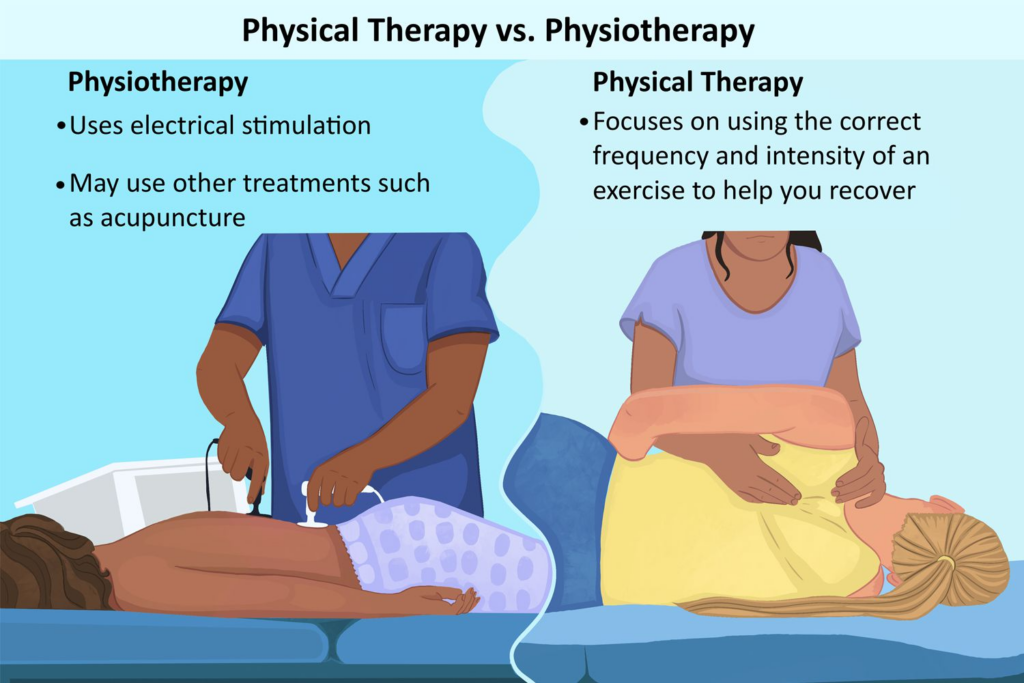
Comparing physical therapy and nursing is complex; both have unique challenges. Physical therapy focuses on rehabilitation, while nursing involves diverse patient care tasks and clinical responsibilities.
Both are demanding professions that are distinct in their scope of activities and responsibilities. PT entails deep understanding of musculoskeletal systems as well as neuromuscular systems. It comprises a lot of physical exercise and patient rehabilitating.
Nursing includes administering drugs to patients, checking their health changes and offering them emotional support. Both require lots of education and training, communication ability alongside empathy. However, this perceived difficulty depends on personal strengths and interests in healthcare.
What goes on during a Physical Therapy Session?
During a physical therapy session, patients receive personalized exercises, manual therapy, and education aimed at improving movement, strength, and function based on their specific condition.
During physical therapy sessions, therapists assess the condition of patients. They get an insight into the patient’s symptoms and goals. Such sessions may include procedures like hand therapies, targeted exercises done with ice and heat or electrical stimulation among others. Therapists instruct exercises for improving strength, flexibility plus mobility.
Consequently, they teach about body mechanics and injury prevention. Typically, a session concludes with summary remarks noting any improvements made within this period and providing instructions concerning home exercises. They help the patient retain gains made with the therapy.
How do insurance reimbursements work?
Insurance reimbursements cover part of medical costs based on policy terms. Patients pay upfront, then submit claims for reimbursement, which insurers process and pay directly.
Insurance compensation is not consistent for physiotherapy:
In some countries with nationalized health care systems, physical therapy might more likely be accessible through governmental insurance packages.
However, US coverage for these services differs based on the state regulations and types of plans used by insurers.
Conclusion
While there are differences in terms, educational necessities, degrees, etc based on the country these two professionals share the same aim. Both of them focus on improving patient’s mobility, functionality and overall quality of life through different therapeutic techniques. Both of these professions require rigorous training before they can start practicing on their own.
References
Physical Therapy
Physical therapy (PT) is a key component in the healthcare industry that focuses on improving the physical function and mobility of patients while taking care of their pain, avoiding impairment, and promoting general fitness and health.
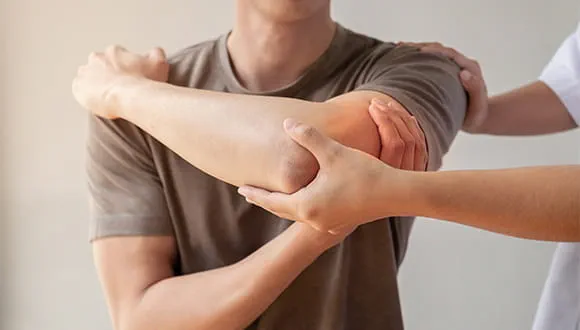
Physical therapy is a key part of the recovery and rehabilitation process as it helps return mobility, decrease pain, and restore function. It is a kind of treatment that makes anyone throw away their walking stick whether it’s an injured sportsman or an old person with arthritis.
What is the primary goal of physical therapy?
The primary goal of Physical therapy is to restore movement and function while alleviating pain. Therapists use exercises, manual therapy, and education to achieve this. The goal is to enhance mobility and overall quality of life, empowering patients to manage their conditions independently and effectively.
This is done by a mixture of therapeutic exercises, manual techniques, and educational strategies. Therapists alleviate pain and functional impairments in order to empower patients to regain independence. It focuses on rehabilitation and prevention for the long term so that people may cope with their various problems and lead healthy, active lives with improved daily functioning.
How long does a physical therapy session last?
A typical physical therapy session lasts 30 to 60 minutes. The duration depends on the treatment plan and the patient’s condition. Each session includes exercises, hands-on therapy, and progress evaluations to ensure effective rehabilitation and personalized care for optimal recovery.
Treatments include exercises, manual therapy, and follow-up assessments for checking on the progress achieved. The idea is to provide complete care for the condition of the patient and simultaneously promote effective rehabilitation. These regular assessments during sessions modify the treatment plan to bring out the best recovery and achieve all the set or aimed-for therapeutic targets.
What should I wear to a physical therapy session?
Wear comfortable, loose-fitting clothing that allows free movement during exercises. Athletic wear, such as shorts or sweatpants and a t-shirt, is ideal. Proper footwear, like sneakers, supports safe and effective therapy, ensuring ease of movement and comfort throughout the session.
Proper footwear includes shoes that can provide support, like sneakers. Loose clothes and comfortable shoes will allow you to participate in all activities without feeling any discomfort. It also allows the therapist to examine and treat your problem area without any kind of hindrance. All this preparation helps to make your therapy experience more effective and enjoyable.

How often should I attend physical therapy?
The frequency of physical therapy sessions varies based on individual needs and treatment goals. Typically, patients attend 2-3 sessions per week. Your physical therapist will adjust the schedule according to your progress, ensuring optimal recovery and improvement in mobility and function.
Your physical therapist will closely monitor your progress and adjust the frequency as needed to allow you to recover optimally. The frequency of visits is determined by regular reassessments, adjusting the plan based on how your mobility, strength, and overall function have improved.
What types of conditions can physical therapy treat?
Physical therapy treats various conditions, including musculoskeletal injuries, post-surgical rehabilitation, chronic pain, and neurological disorders. It helps improve mobility, strength, and function, addressing issues like sports injuries, arthritis, back pain, and stroke recovery through targeted interventions.
Generally speaking, therapists use very specifically targeted interventions to improve mobility, strength, and overall function. Properly done, with a focus on specific conditions and using the right therapeutic techniques, physical therapy allows for improved quality of life and furthers recovery from several physical and functional impairments.
What are common techniques used in physical therapy?
Physical therapists use techniques like therapeutic exercises, manual therapy, and modalities such as heat, ice, and ultrasound. These methods help reduce pain, improve mobility, and restore function. Education on posture and ergonomics also plays a key role in enhancing recovery and preventing recurrence.
On the other hand, manual therapy is a hands-on method used for the manipulation of muscles and joints. Modalities are provided for pain and inflammation through heating or ice application. Education on proper posture and ergonomics is integral to preventing future problems while supporting full recovery. These combined approaches address various dimensions of rehabilitation for its effective treatment.
Is physical therapy painful?
Physical therapy should not be painful, though some discomfort may occur during exercises as the body adapts. Therapists ensure exercises are within tolerable limits, gradually increasing intensity. Open communication with your therapist is vital to tailor treatment and minimize any discomfort.
The therapist tries to maintain the exercises in bearable limits and slowly increases the intensity based on the progress of the patient. More than anything else, the key to good therapy is open communication with your therapist in order to ensure that discomfort will be appropriately handled and the treatment plan altered to minimize pain while optimizing recovery and maintaining comfort and safety throughout.

How do I prepare for my first physical therapy session?
To prepare for your first session, wear comfortable clothing and bring any relevant medical records or physician referrals. Arrive early to complete paperwork and discuss your medical history and treatment goals with your therapist. Be ready to engage in exercises and ask questions.
Allow ample time for any paperwork and discussing your history, current condition, and what the goals of treatment are. Now, be prepared to do exercises and ask questions to make sure that you get all you can from the session.
What can I expect during a physical therapy evaluation?
During an evaluation, the therapist assesses your medical history, current condition, and movement limitations. They conduct physical exams, discuss your goals, and develop a personalized treatment plan. This comprehensive assessment ensures a tailored approach to address your specific needs effectively.
They will look into the physical examination findings on movement limitations, strength, and flexibility. Referring to that assessment and your personal goals, the therapist will create a treatment plan tailored to what you need. This detailed assessment helps to individualize your therapy by charting a specific course of action toward improved function, pain alleviation, and accomplishment of your general rehabilitation goals.
What are the benefits of physical therapy?
Physical therapy benefits include improved mobility, pain reduction, increased strength, and enhanced function. It supports recovery from injuries, prevents future issues, and promotes overall well-being. By addressing root causes, therapy empowers individuals to manage their health proactively and effectively.
It enables the patient to take care of his health by dealing with the causes of their physical problem and implementing an individualized treatment program. The comprehensive approach offers not only help during a phase of rehabilitation but toward better health and functional independence at the end.
Wrapping up,
We have looked at several aspects of how patients undergo procedures involving attending a session, for instance, on undergoing them today if one decides to take part in PT. This means it is important to consult a qualified physical therapist first, who will assist in developing an individualized treatment plan. This is a journey that can significantly boost your health and well-being overall, thus giving you more than just recovery but also a redefinition of mobility and freedom. Keep in mind that going through physical therapy every step means a healthier life thereafter.
Physical Therapy
Physical therapy (PT) is a key component in the healthcare industry that focuses on improving the physical function and mobility of patients while taking care of their pain, avoiding impairment, and promoting general fitness and health.

Healthcare specialty, physical therapy concentrates on restoring movement and functions of the body through specialized exercises and treatment. There are many advantages associated with this practice, such as pain elimination; better mobility; and quick recovery from injury, among others. Early intervention is key to success here because waiting may worsen the situation or even become untreatable. This field serves different persons, including players; patients who have gone through surgery or accidents, and those suffering from long-term pains/aches or limited movement ability due to various reasons.
What are common signs that you might need physical therapy?
Common signs include persistent pain, limited mobility, and difficulty performing daily tasks. Physical therapy can help with recovery from injury, surgery, or chronic conditions.
A visit with a healthcare provider should be able to determine whether therapy is needed on the symptoms shown and the functional limitations reported. In case you have continuous pain that doesn’t seem to improve with some rest and medication or if you are having reduced ranges of motion at joints, then the case will be taken care of by physical therapy. Trouble in performing everyday activities like walking, climbing stairs, lifting, etc., may also call for professional help.
How does physical therapy help with injury recovery?
Physical therapy aids injury recovery by improving strength, flexibility, and range of motion. Therapists design personalized exercise programs to target affected areas, reducing pain and preventing re-injury.
This increases blood flow to the affected area, promoting tissue repair, which aids in quick healing. It involves manual therapy techniques, targeted exercises, and modalities such as heat or cold therapy to address inflammation and promote healing. Restoring function to the injured muscle, ligament, or tendon, allows a patient to return to normal activities safely and effectively.

Can physical therapy prevent surgery?
Physical therapy can prevent surgery by addressing underlying issues, improving function, and reducing pain. It strengthens muscles and improves joint stability, which may eliminate the need for invasive procedures. Early intervention is key to maximizing therapy’s preventative benefits.
Treatment early on can help gain the most from therapy’s preventative effects. Conditions like osteoarthritis and herniated disks can be managed by physical therapy; in these, the strengthening of the muscles around those parts and increasing flexibility relieves the symptoms. Many times, restoring the normal movement pattern by reducing the stress to joints may sometimes obviate surgical intervention.
How does physical therapy assist with chronic pain management?
Physical therapy assists with chronic pain by addressing its source through exercises, manual therapy, and modalities. It improves flexibility, strength, and posture, reducing pain and enhancing quality of life.
Therapy teaches self-management techniques to deal with persistent discomfort. The physical therapist examines one’s patterns of motion to find out what’s wrong and what the pain contributors are after which an individual exercise plan is designed to eradicate the cause.
Such techniques as dry needling or ultrasound therapy might be applied in order to better control pain. Strategies taught in this area include methods of pain management in the form of ergonomic adjustments and alleviating techniques of stress.
What role does physical therapy play in post-surgery recovery?
Physical therapy plays a crucial role in post-surgery recovery by restoring function, reducing swelling, and preventing complications. It involves exercises to regain strength and flexibility and promotes a safe, gradual return to activities.
Therapy supports healing by minimizing scar tissue formation. To regain flexibility and develop muscular strength, physical therapists assist patients to move around and do some stretching exercises after surgery. Massage and joint mobilization are applied in techniques to create less stiffness in the body, allowing blood to circulate well, hence making recovery effective without any complications.
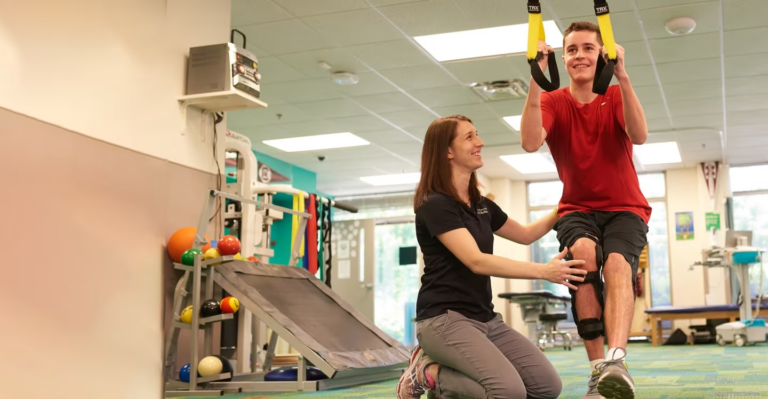
How can physical therapy improve mobility for older adults?
Physical therapy improves mobility for older adults by enhancing balance, strength, and flexibility. It addresses age-related conditions like arthritis and osteoporosis, reducing fall risk.
A therapist designs a personal exercise program to help the elderly maintain independence and improve their quality of life. For seniors, muscle weakness and joint stiffness, commonly underlying causes of mobility issues, maybe the main focus of physical therapy. Balance exercises and gait training prevent falling, and strength-building activities enhance function in day-to-day life. Regular sessions give support to continued mobility and activity.
How do I determine if physical therapy is right for me?
Determining the need for physical therapy involves assessing symptoms, consulting a healthcare provider, and evaluating functional limitations. Persistent pain, decreased mobility, and difficulty with daily activities are key indicators.
Professional advice can, therefore, be sought to guide one in decision-making. A health care provider can evaluate your condition and refer you for physical therapy if it is likely to improve your symptoms and function. In cases of surgery, injury, or chronic conditions that affect movement, PT can be very useful. This also is good to discuss with a therapist about goals and expectations.
Wrapping Up!
Physical therapy should be thought of as a solution/answer when one has continuously suffered, can’t move; loses balance, or is still recovering from an injury while managing the chronic disease. Personalized plans aimed at enhancing performance and reducing pain may be created by certified therapists. Therefore, towards improving your health do not be afraid to. Use physical therapy as a means of taking back authority over your welfare and living a fulfilled life that is more active.
